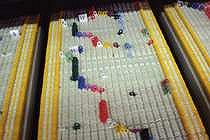
|
Achleitner’s Austria The Archive of Twentieth Century Architecture Location: Architekturzentrum Wien - Old hall Exhibition: 18 May 2000 - 07 August 2000 Opening: Wednesday 17 May 2000, 7pm Four detailed building-biographies thematicize a central aspect of archival recording and the analysis of building history. STAFA-Departmentstores Villa Eichmann House Gamerith Vorarlberg College of Applied Science Eurocenter Mariahilf formerly STAFA-Departmentstores Mariahilfer Strasse 120, A-1070 Vienna 1910 - 1911 Architect: Jakob Wohlschläger The present building still shows traces of what was once known as the "1st Vienna Collective Sample-Warehouse” (a.k.a. "Mariahilf Central Palace”). The cylindrical building with glass covered court exhibited not only provocative form, it was also a declaration of economic war upon the large department stores, which the socially engaged politician and architect Jakob Wohlschläger undertook without any sort of public subsidy whatsoever. The concept was to offer small-scale, financially distressed handworkers with presentation and sales assistance for their products. Friedrich Achleitner, in: Austrian Architecture in the 20th Century Vol. III/1, Vienna 1-12 District, Salzburg and Vienna 1990. STAFA-Departmentstores (“Zentralpalast”) Mariahilferstrasse 120, A-1070 Vienna Villa Eichmann Litzlbergerstrasse 37, (previously Litzlberg No. 27) Seewalchen am Attersee, Upper Austria 1927- 1928 Architect: Clemens Holzmeister Friedrich Achleitner, in: Austrian Architecture in the 20th Century Vol. 1, Upper Austria, Salzburg, Tyrolia, Vorarlberg, Salzburg und Wien 1980. The Eichmann house is not only one of Holzmeister’s finest residential buildings, it ranks amongst the most beautiful ensembles in and around Attersee as well. The house sits like a castle high upon a sloping mead; its symmetry – sculpturally and spatially relieved through Holzmeister’s mastery in detail – accentuates the landscape of its setting. The concave form of the side towards the lake was Holzmeister’s response to the client’s wish that even rooms upon the end facades receive a view of the See. The ground plan is a variation upon the typology of an English Country House. The "outstanding Max Fellerer” (Holzmeister) participated in the execution of the furnishings. The boathouse is a masterpiece in and of itself; it received almost unparalleled exposure in the publications of its time. Its plastic effect is certainly a product of its volumetric unity, which, despite its sculptural variegation, seems to be of a single cast. Today, the entire complex is property of the State of Upper Austria and one can only hope that the singular worth of this ensemble will be respected. House Gamerith Unterbuchberg 21 Seewalchen am Attersee, Upper Austria 1933 -1934 Architect: Ernst Anton Plischke Friedrich Achleitner, in: Austrian Architecture in the 20th Century Vol. I, Upper Austria, Salzburg, Tirol, Vorarlberg, Salzburg and Wien 1980. The legendary "House on Attersee” – for which, together with the Employment Office in Liesing, Plischke received the Great State Prize in 1935 – would hardly have a chance at surviving design review today. The house, one of the finest examples of "Building in the Landscape”, stands diametrically opposed to what would presently considered to be " building that respects the landscape”. The misunderstanding lies in the fact that the landscape today is no longer considered to be an elementary entity of nature (to which cities in the 30’s had their own specific relationship), rather, that it is something that is now bound up with the idea of a rural culture. This means that a house which responds "only” to topography, sun, view, wind, climate or the landscape as natural space would be considered misplaced if it doesn’t also respond to elements of the building tradition that are present in its surroundings. Of course, no effort is made to intelligently define the substance of building culture in the landscape (which would be in Attersee for over the last 100 years a bourgeois-urban tradition), instead it is considered correct only when one overtly mimes elements of rusticality. Plischke himself provides an impressive description of the design: "The building is pure expression of skeletal wood construction. To avoid catching water running down the slope, the continuous wood posts are placed upon concrete blocks. This spares expensive waterproofing. The floor construction is a massive plate constructed from tightly fit tree-trunks, which insures a warm and comfortable floor. An insulating air-space is located between the ceilings and the rafters. The perceivable division between ceiling and roof provides a clear yet relaxed differentiation of the building mass. The continuous window-wall is an independent element cantilevered in front of the wood skeleton. The overhanging roof protects the windows from the summer sun, yet allow full solar penetration in winter. In order to bring the outline of the house into harmony with its wooded backdrop, wood lattices were used during the design process to test positioning upon the site. Simultaneously, the effectiveness in which the windows framed the landscape was controlled through the help of scaffolding.” One could well describe the sum of these ideas as "Building with the Landscape”. Vorarlberg College of Applied Science formerly Federal School for Textile Technology / Vorarlberg College of Applied Science Achstrasse 1, A-6850 Dornbirn 1954 -1960 Friedrich Achleitner, in: Austrian Architecture in the 20th Century Vol. I, Upper Austria, Salzburg, Tyrolia, Vorarlberg, Salzburg and Vienna 1980. Architects: German Meusburger, Willi Ramersdorfer A typical example of the Architecture of Optimism from the 50’s which contented itself with the application of formal elements from the so-called "International Style”. The proximity of Vorarlberg to neighboring Switzerland accelerated the acceptance of this approach. |
 |
|
© Pez Hejduk |
|
Current Preview Permanent Exhibition Achleitner’s Austria Press Release Areas Buildings Biography |
| © Architekturzentrum Wien 2024 |
||



